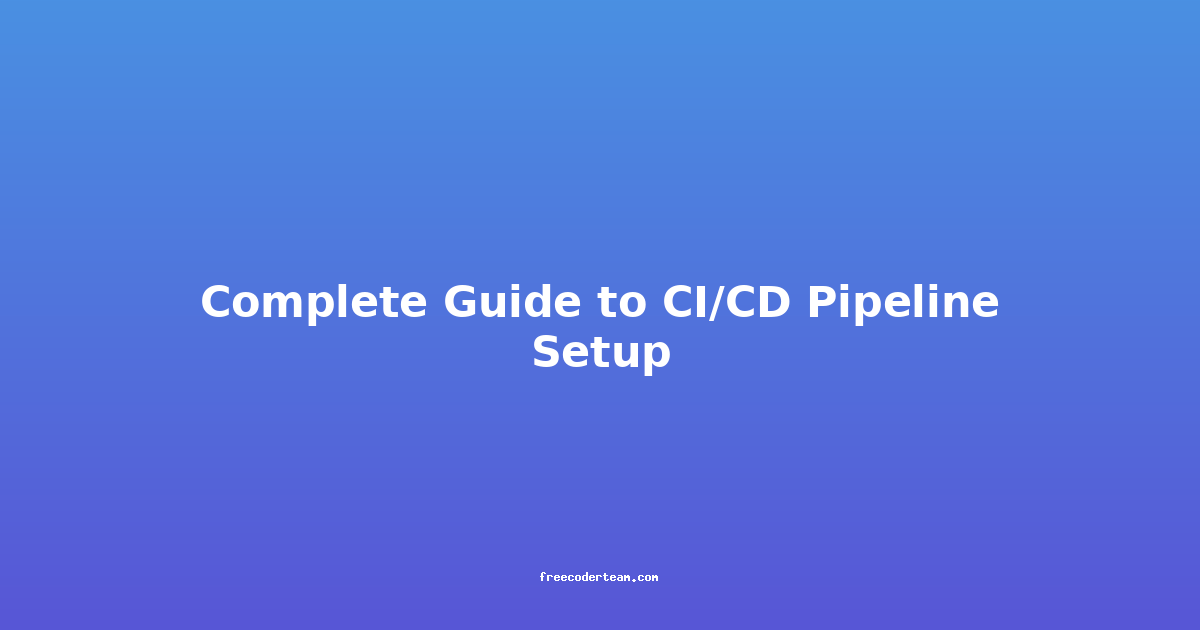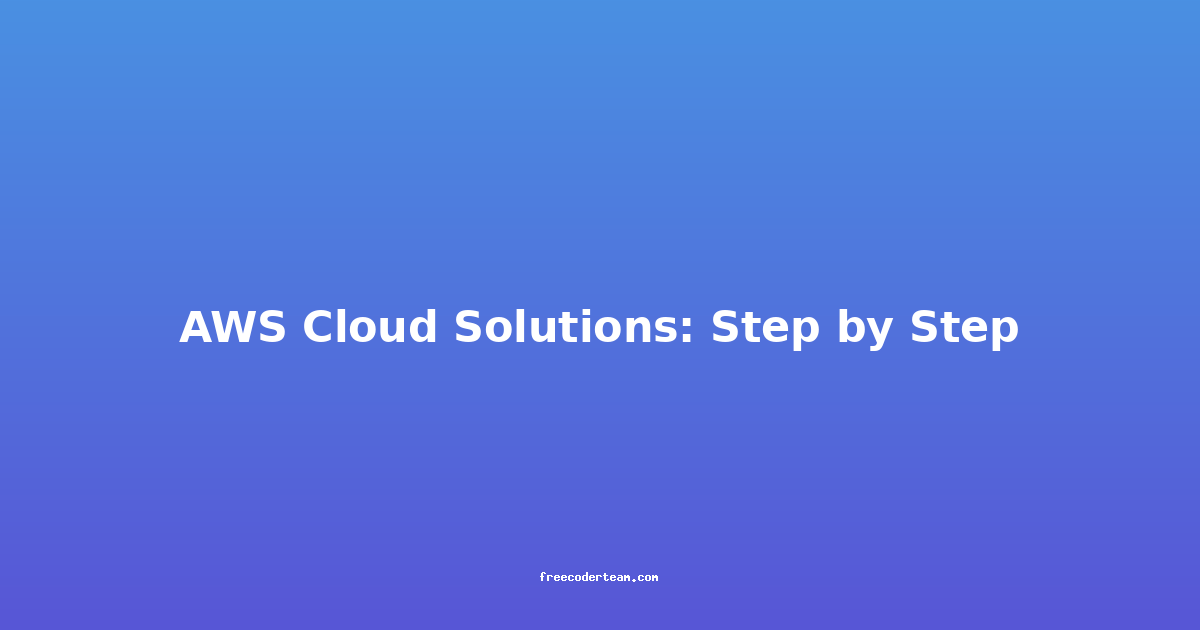Complete Guide to CI/CD Pipeline Setup: A Practical Guide
Continuous Integration/Continuous Delivery (CI/CD) is the backbone of modern software development, enabling teams to deliver high-quality code faster and more reliably. In this comprehensive guide, we’ll explore the key concepts, best practices, and actionable steps to set up an effective CI/CD pipeline. Whether you’re a beginner or a seasoned developer looking to optimize your workflow, this guide will provide you with the insights and practical examples you need.
1. Understanding CI/CD
1.1 What is CI/CD?
CI/CD is a software development practice that automates the integration, testing, and delivery of code changes. It consists of two main components:
- Continuous Integration (CI): Developers regularly merge their code changes into a shared repository, triggering automated builds and tests to catch issues early.
- Continuous Delivery (CD): Once code passes CI tests, it is automatically prepared for deployment, either into a staging environment or directly to production.
1.2 Why Use CI/CD?
- Faster Feedback Loops: Developers receive instant feedback on their code changes, reducing the time to identify and fix bugs.
- Reduced Human Error: Automation minimizes manual errors, ensuring consistency in builds and deployments.
- Improved Collaboration: Teams can work in parallel and integrate changes frequently, avoiding merge conflicts.
- Accelerated Time-to-Market: CI/CD enables rapid, reliable releases, allowing businesses to respond quickly to market demands.
2. Key Components of a CI/CD Pipeline
2.1 Source Control Management (SCM)
- Tools: Git, GitHub, GitLab, Bitbucket
- Purpose: Central repository for storing and versioning code.
- Best Practice: Use feature branches for development and merge changes into the main branch only after validation.
2.2 Build and Test
- Tools: Jenkins, GitHub Actions, GitLab CI/CD, Travis CI
- Purpose: Automate building, testing, and packaging of the application.
- Best Practice: Run unit tests, integration tests, and static code analysis during the build phase to ensure code quality.
2.3 Artifact Management
- Tools: Docker, Nexus, JFrog Artifactory
- Purpose: Store and manage build artifacts (e.g., binaries, packages, Docker images).
- Best Practice: Use versioning for artifacts to ensure traceability and reproducibility.
2.4 Deployment
- Tools: Kubernetes, AWS ECS, Heroku, Ansible
- Purpose: Automate the deployment of the application to various environments (development, staging, production).
- Best Practice: Implement blue-green deployments or canary releases to minimize downtime and risk.
2.5 Monitoring and Feedback
- Tools: Prometheus, Grafana, Datadog, New Relic
- Purpose: Monitor the health and performance of the deployed application.
- Best Practice: Set up alerts for critical issues and feedback loops to continuously improve the pipeline.
3. Setting Up a CI/CD Pipeline
3.1 Step 1: Choose Your Tools
Depending on your project requirements, you can choose from a variety of tools. Here’s a popular stack:
- CI/CD Platform: GitHub Actions, GitLab CI/CD, Jenkins
- Source Control: GitHub, GitLab
- Containerization: Docker
- Artifact Management: Nexus, JFrog Artifactory
- Deployment: Kubernetes
3.2 Step 2: Define Your Pipeline Stages
A typical CI/CD pipeline includes the following stages:
- Clone: Fetch the latest code from the repository.
- Build: Compile and package the application.
- Test: Run unit tests, integration tests, and linting.
- Deploy: Push the application to the desired environment.
- Monitor: Track the application’s performance and gather feedback.
3.3 Step 3: Write Your CI/CD Configuration
Example: GitHub Actions for a Node.js Project
Below is a simple .github/workflows/ci-cd.yml file for a Node.js application:
name: CI/CD Pipeline
on:
push:
branches:
- main
pull_request:
branches:
- main
jobs:
build-and-test:
runs-on: ubuntu-latest
steps:
- name: Checkout code
uses: actions/checkout@v3
- name: Setup Node.js
uses: actions/setup-node@v3
with:
node-version: '16'
- name: Install dependencies
run: npm install
- name: Run tests
run: npm test
- name: Build application
run: npm run build
deploy:
needs: build-and-test
runs-on: ubuntu-latest
if: github.ref == 'refs/heads/main'
steps:
- name: Checkout code
uses: actions/checkout@v3
- name: Setup Node.js
uses: actions/setup-node@v3
with:
node-version: '16'
- name: Install dependencies
run: npm install
- name: Build application
run: npm run build
- name: Deploy to server
run: |
# Example: Deploy to a server using SSH
ssh -i ${{ secrets.SSH_PRIVATE_KEY }} user@your-server <<EOF
cd /path/to/app
git pull
npm install
npm run build
pm2 restart app
EOF
Explanation:
- Build and Test: This job runs whenever code is pushed to the
mainbranch or a pull request is opened. It checks out the code, installs dependencies, runs tests, and builds the application. - Deploy: This job is triggered only when the
mainbranch is updated and depends on thebuild-and-testjob. It deploys the application to a server using SSH.
3.4 Step 4: Automate Deployment
For a more advanced deployment, you can integrate tools like Kubernetes. Here’s an example of deploying a Dockerized Node.js app to Kubernetes:
Dockerfile:
FROM node:16-alpine
WORKDIR /app
COPY package*.json ./
RUN npm install
COPY . .
CMD ["npm", "start"]
Kubernetes Deployment YAML:
apiVersion: apps/v1
kind: Deployment
metadata:
name: nodejs-app
spec:
replicas: 1
selector:
matchLabels:
app: nodejs-app
template:
metadata:
labels:
app: nodejs-app
spec:
containers:
- name: nodejs-app
image: your-docker-registry/nodejs-app:latest
ports:
- containerPort: 3000
Example Workflow:
- Build the Docker image using GitHub Actions.
- Push the image to a container registry (e.g., Docker Hub, AWS ECR).
- Deploy the image to Kubernetes using a
kubectlcommand.
4. Best Practices for CI/CD
4.1 Keep Pipelines Fast
- Optimize Tests: Prioritize unit tests over slow integration tests.
- Parallelize Tasks: Use matrix builds to run tests in parallel.
- Cache Dependencies: Reuse installed dependencies across builds to reduce setup time.
4.2 Ensure Consistency
- Standardize Environments: Use containerization (e.g., Docker) to ensure the development, testing, and production environments are identical.
- Use Version Locks: Pin versions of dependencies to avoid unexpected behavior.
4.3 Monitor and Improve
- Collect Metrics: Track pipeline performance, test coverage, and deployment success rates.
- Implement Feedback Loops: Use monitoring tools to gather feedback and improve the pipeline over time.
4.4 Secure Your Pipeline
- Use Secrets Safely: Store sensitive information (e.g., API keys, passwords) in the CI/CD platform’s secret management system.
- Limit Access: Restrict who can trigger deployments and modify the pipeline configuration.
5. Common Challenges and Solutions
5.1 Slow Builds
Solution: Use caching to store and reuse dependencies, parallelize test suites, and optimize build scripts.
5.2 Flaky Tests
Solution: Improve test stability by mocking external dependencies, using deterministic data, and rerunning failed tests.
5.3 Deployment Failures
Solution: Implement rollback mechanisms, use blue-green deployments, and automate health checks post-deployment.
6. Conclusion
Setting up a CI/CD pipeline is a foundational step towards modern, efficient software development. By automating the integration, testing, and deployment processes, teams can deliver high-quality software faster and with fewer errors. Whether you’re starting from scratch or optimizing an existing pipeline, following the best practices and using the right tools will help you achieve success.
7. References and Further Reading
- GitHub Actions Documentation
- GitLab CI/CD Documentation
- Jenkins Documentation
- Kubernetes Documentation
By implementing CI/CD, your team can focus on innovation rather than manual, error-prone processes. Embrace automation, and watch your development efficiency soar!
Note: The examples provided are simplified for clarity. In production, you may need to adapt them based on your specific use case and security requirements.




